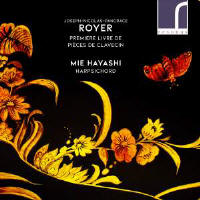Texte paru dans: / Appeared in: |
|
|
Reviewer: Bertil
van Boer
For composers living in France
during the first half of the 18th century, there must have been considerable
pressure to live up to the keyboard pieces or books published by François
Couperin (also reviewed in this issue). These were intellectual exercises,
most of them, with the intent of providing a civilized society with a set of
social music that demonstrated ability, as well as contained allusions to
various things. These books were filled with titled works, generally with
the notion that the performers would delight in the subtle twists and turns,
an effort that, if successful, would earn them a reputation both for their
theoretical skill as well as their popular content. One can be reminded of
Jean-Philippe Rameau, whose Pièces de clavecin from 1724 onwards established
him as one of the foremost followers or successors to the aging Couperin.
Few, however, have probably ever heard of Joseph-Nicholas-Pancrace Royer
(1703–1755). The son of a Savoy military man, he came to Paris at an early
age, where he first began a career as an administrator at the Opéra, and
then in 1748 led the famed Concerts spirituels. He also taught members of
the court of Louis XV, and he was known primarily for his various theater
works, especially the ballets de cour. Given his stature in Paris as a
musician, he was probably destined to publish this volume of pieces, meant
mainly for the well-heeled amateurs of the time.
One oddity is that he uses no
fewer than six different clefs, possibly to add an additional challenge to
his would-be performers. The movements are titled, giving them a slightly
old-fashioned, Couperinesque feel. They range in style from simple and
naïve, such as “La bagatelle,” which he then turns into a minor key
variation entitled “suite.” “Le vertigo” is a rondeau that teeters and
totters about various keys, suddenly falling precipitously down a scale or
arpeggio. Nothing is stable, either melodically or harmonically, lending it
a sort of air of a fantasy. There is even a rather manic moment in which the
keyboard is mechanically pounded, but ending in a whirling froth. “Le Zaïde”
is a tender and quite languid piece, clearly a characterization based upon
some stage persona. The set ends with a Scythian march, a harmonically
bizarre movement that wanders about with some chromatic passagework and a
monotonous main theme. A final flourish that stops abruptly and with
swishing patterns returns back to the mincing main theme. The harpsichord is a modern copy by Andrew Garlick of a 1749 Goujon, just the sort of instrument that would have been used in Paris. The sound is robust and pointed, and harpsichordist Mie Hayashi does an absolutely outstanding job of performance. She knows instinctively how to phrase the often gnarly passagework that Royer demands, making it exciting and musical, rather than just an intellectual exercise. There is a base canard that all French harpsichord music after the death of Couperin was nothing but a pale imitation. This fine recording should put that idea to rest. Highly recommended.
| |
|
|
|
|
|
|
|
Cliquez l'un ou l'autre
bouton pour découvrir bien d'autres critiques de CD |
|




